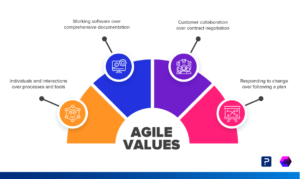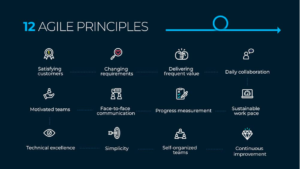In a world with everchanging conditions and unexpected events, the age-old five-year strategies and action plans are suddenly being replaced by agile strategies and plans. And agile strategies and plans require agile organizations and leaders. But what is agile? How can it really help a business thrive in this age of flux? And if it really is helpful, how can organizations build agile cultures and leaders?
If you’re interested in answering these questions, read on to know more about how to develop an agile organization and leadership.
First things first, what is Agile?
Agile is a project management methodology that originated in the software development industry in the early 2000s. Contrary to the waterfall methodology, it is a methodology that focuses on continuous iteration and open communication to meet changing customers’ needs. The principles and values that govern the Agile methodology have been outlined in the Agile Manifesto which was created by some of the notable Agile leaders of software development in 2001.

Agile Values
The Agile Manifesto outlines four values that make it easy to understand what Agile management is all about. Here are the values that Agile teams live by:
Individuals and interactions over processes and tools
In a fast-paced world with changing customers’ needs, as a leader, you need to put less emphasis on process and more emphasis on people. That includes all aspects of people management starting from hiring the right people all the way to motivating them. The focus here is on achieving results fast by leveraging ‘people power’ rather than following long processes that may or may not achieve results.
At the heart of this value too lies the Agile focus on face-to-face interaction as a more effective and time-efficient alternative to emails and reports to save time and create opportunities for fruitful collaboration.
Working software over comprehensive documentation
Due to its origins in the software development field, this value emphasizes the importance of working software. For leaders from other industries, however, tangible results can be used as a substitute for ‘working software’. Read this way, this value emphasizes results over documentation. A 2019 State of Work report released by Workfront surprisingly shows that employees on average spend around 60% of their time on tasks unrelated to their primary jobs. But as an Agile leader, you need to maximize your team’s amount of time spent on achieving results.
Customer collaboration over contract negotiation
Agile leaders understand that the reason they are in business is to serve the customer. They also understand that both they and the customers may not start out with a clear understanding of their own requirements. Moreover, what the customer wants can always change.
This is why one of the tenants of Agile leadership is maintaining a continuous two-way channel of communication with customers to understand their changing needs. The trick, though, is not only to understand these changes but to respond fast enough to them. Cue in the fourth value.
Responding to change over following a plan
Agile management shatters the deep-set perception of a manager as someone who sets a long-term plan and then spends the remainder of their time following up on its progress. Instead, as an Agile leader, you understand that plans are not set to be followed but rather to be continuously changed. An Agile leader emphasizes the continuous collection of customer feedback and the continuous creation of plans that act on this feedback.
It is important to note, though, that the Agile Manifesto dubbed these values with this statement, ‘that is, while there is value in the items on the right, we value the items on the left more.’ That is to say that Agile teams do not operate with zero documentation, customer contracts, processes, or plans. The crux of the matter is that they do not prioritize them. In an Agile team, if you must choose between results or process, choose results. If you need to choose between changing requirements or following a long-set plan, welcome the change.

Building Agile Organizations
Of course, such as with everything in life, these values may seem easier said than done, so to help you put these Agile values into practice and move towards becoming an Agile leader, here are some of the main aspects you may need to work on in your organizational transformation process.
Teams
Structure your teams to be multi-disciplinary and structure your workspace to be an open space that allows for face-to-face communication. For multi-disciplinary teams to be effective, try to reduce hierarchy and promote self-organized teams. Build both a process and a culture for peer-to-peer accountability and distributed leadership. Processes that can help you with this are setting daily stand-up meetings or weekly retrospectives among team members, championing cross-functional self-led initiatives, and encouraging small-scale risk-taking.
Processes
Making the shift to Agile does not mean eradicating all company processes and simply drifting on free-float mode. As per the theory of constraints, individuals become more creative in the presence of constraints, not the lack thereof. Therefore, you still need to have a few processes, but the trick is to have as few processes as possible to structure work and spur creativity.
Strategies
Being an agile leader does not mean operating in a state of total lack of strategy. Instead, another word for strategy in an agile organization is ‘direction’. An agile strategy helps give your employees direction as to where the company is going, why, and how.
Stanford professor of Organizational Behavior, Jesper Sorensen, draws the analogy between your company strategy and a good story. He advises that your strategy is your company story. If you are going to tell someone a story about what your company is, what it’s doing, and why it will succeed, will the story hold together? If the story holds, you have got a good strategy. If the story does not hold, you need to work on pivoting your strategy. As Jeff Bezos puts it, ‘Be stubborn on the vision and strategy and flexible on the details and tactics.’
Learning & Experimentation:
At the heart of Agile is the core belief that an effective organization never stops learning from its customers, markets, and its own mistakes. This is why, as an Agile leader, it is essential that you promote a culture of risk-taking and learning from mistakes.
Promoting such a culture cannot work without putting the appropriate structures in place. For example, perhaps you can set your team members’ workload to be 80% results-focused and 20% learning-focused. You can even set learning and innovation goals and KPIs or perhaps you can set a monthly team event where failures resulting from active innovation and experimentation are celebrated.
There are many ways by which you can make the transition to becoming an Agile leader. Start with the ones you are more comfortable with then move to the more challenging ones.

Agile Principles
Before you go ahead in your journey of transition, we would like to leave you with the twelve Agile principles as developed in the Manifesto.
These principles were originally created to meet the needs of the software development industry, but we have tweaked them to meet the needs of almost any industry:
- Our highest priority is to satisfy the customer through early and continuous delivery of results.
- Welcome changing requirements, even late in product development. Agile processes harness change for the customer’s competitive advantage.
- Deliver results frequently, from a couple of weeks to a couple of months, with a preference to the shorter timescale.
- Business people and product developers must work together daily throughout the product development process.
- Build projects around motivated individuals. Give them the environment and support they need, and trust them to get the job done.
- The most efficient and effective method of conveying information to and within a team is face-to-face conversation.
- Results that match customers’ requirements are the primary measure of progress.
- Agile processes promote sustainable development. All team members should be able to maintain a constant pace indefinitely.
- Continuous attention to product excellence and good design enhances agility.
- Simplicity–the art of maximizing the amount of work not done–is essential.
- The best products, services, and designs emerge from self-organizing teams.
- At regular intervals, the team reflects on how to become more effective, then tunes and adjusts its behavior accordingly.
Start Agile Now
This was a simple introduction to what Agile management is and how you can live its values and principles. If you feel overwhelmed by this all, simply make these four areas at the center of your focus: people, customers, change, and results. For more in-depth information about Agile management, check our online courses HERE.
How We Can Help
At XpertLearning, we have some of the best online leadership development programs that you can use to upskill your teams and build your next generation of leaders. Contact us at enquiries@xpertlearning.com for more information.

